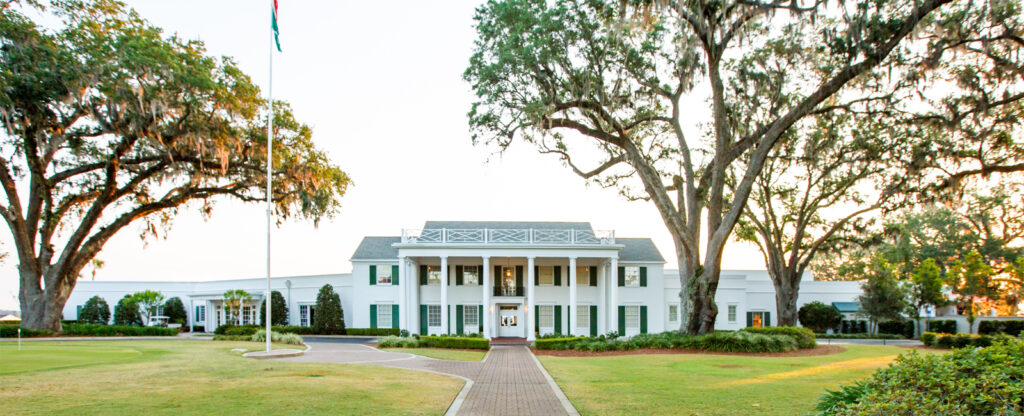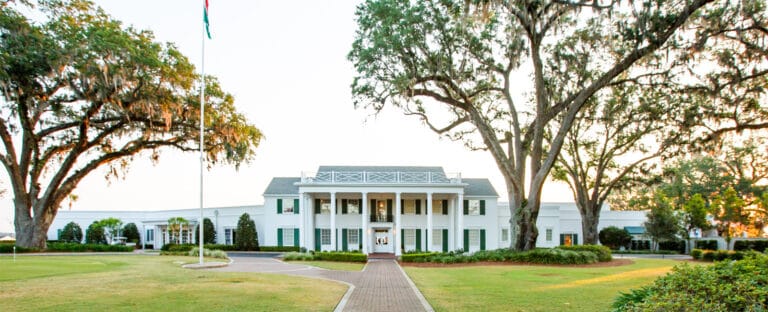Timuquana’s founders organized the club in the early 1920s and hired Donald Ross to lay out the course; the club opened in 1923 with a full Ross routing on roughly 120 acres of pine woods along the river. Contemporary club history pages identify Ross as the original architect and date establishment to 1923. While Ross’s on-site construction calendar is not detailed in surviving club materials available publicly, the timing of the opening (1923) suggests that plan preparation and field work fell in 1922–1923. No documentary evidence surfaced in this research to show Ross returning for a second phase.
Within a generation, member alterations and subsequent architect visits began to modify the original. Robert Trent Jones Sr. worked at Timuquana in the post-war era, including adding a lake at the par-3 5th and re-edging greens as irrigation improved. In the 1960s David W. Gordon added a lake left of the 6th fairway/green and converted the hole to a par 5. George Cobb is also cited in mid-century “tweaks,” although the club’s own capsule history highlights Jones and Gordon rather than Cobb by name. These interventions, along with added trees and changed mowing lines, gradually blurred Ross’s original angles.
A major inflection point came in 1995–96, when Bobby Weed was commissioned to recover the Ross strategy. With limited archival documentation available—Weed has stated he relied heavily on a 1943 aerial photograph—his work emphasized restoring width, re-establishing angles, and simplifying features to accord with the Ross era. Approximately 800 trees were removed, palmetto undergrowth was cleared, and green surrounds were opened to renew the running game. The refurbished course hosted the 2002 U.S. Senior Amateur.
Beginning in 2017 the club embarked on a master restoration plan with architect Bruce Hepner. Phase 1 (post-Hurricane Irma, 2018) rebuilt bunkers; in 2019–2020 the club introduced Trinity zoysia approaches, expanded tees, removed select trees, and added native areas. A full-course closure in 2022 allowed for rebuilding all greens complexes (expanding where surfaces had shrunk), re-grassing fairways and tees, replacing irrigation and substantial drainage, and enhancing the 18th. The work was conceived to reinforce Ross characteristics within the modern maintenance envelope as Timuquana approached its centennial.
Unique Design Characteristics
The riverfront setting shapes play as much as the ground—winds off the St. Johns change the calculus of carries and the viability of running approaches. Ross’s routing harnessed this exposure while keeping holes on modest contours, a theme still legible on today’s short par 4s at Nos. 3 and 11, where restored width and square tee pads invite players to choose lines that open specific pin positions. Photography and architect notes from the Weed era emphasize “simple bunker shapes,” low-profile greens, and open entries, making the ground-game option credible on these two-shot holes.
Mid-round, the S-shaped par-5 12th remains a subtle test. Bunkers pinching the left approach create the impression that the green cants one way when, in fact, it falls the other—an example of the understated deception that Timuquana’s restorations have tried to preserve rather than embellish. At the par-3 16th along the river—regularly highlighted in event imagery—the restored, low-profile green pad and closely mown surrounds keep recovery options open while allowing wind to influence trajectory.
While mid-century lakes at Nos. 5 and 6 are not Ross originals, their presence today interacts with Ross’s corridors: the 6th in particular, converted to a par 5 in the 1960s, now asks for positional drives to regain the angle that tree growth and lakes long obscured. Overall, the clearest surviving expressions of Ross intent are seen in the routing’s cadence—a run of short/medium two-shot holes punctuated by reachable fives—and in the use of crowned or subtly domed green surfaces (originally for drainage) that keep misses honest without resort to excessive bunkering.
Historical Significance
Within Ross’s Florida work, Timuquana occupies an instructive place: a 1923 coastal-plain routing whose original strategic ideas were substantially recoverable after decades of additions. Early club life was lively; the 1928 Florida Amateur was staged here (won by the club’s president, A.C. “Al” Ulmer), and exhibitions by Walter Hagen, Horton Smith, Gene Sarazen, and Johnny Farrell introduced national-caliber golf to Jacksonville members. In the modern era, the course has hosted the 2002 U.S. Senior Amateur and the 2019 U.S. Women’s Amateur Four-Ball, and since 2021 it has served as host for the PGA TOUR Champions’ Constellation Furyk & Friends—evidence that a Ross-era routing, carefully tended, can stage contemporary championship play without losing its member-course character.
Current Condition / Integrity
The routing is substantially Ross, with mid-century modifications (notably lakes at 5 and 6) and later stylistic drift now addressed by two restoration waves. Weed’s 1996 work reopened fairway widths and simplified presentation; Hepner’s multi-year plan (2018–2022) rebuilt the infrastructure, restored shrunken green edges, replaced bunkers in keeping with the historic look, and converted approaches to Trinity zoysia, reinforcing the running-approach option. As of the 2022 reopening, all greens complexes are new-built within the historical footprints, tees and fairways were re-grassed, and irrigation/drainage replaced, with a specific enhancement of the finishing hole. Championship setups now vary the course between ~6,827 and ~7,005 yards, but the day-to-day member card remains around 6,859 yards at par 72. In short, what survives most clearly is Ross’s sequence and strategy—angles into greens rather than forced carries—overlaid on modern grasses and irrigation.
Sources & Notes
Timuquana Country Club — “About the Club” (club history, authorship, recent improvements).
Timuquana Country Club — “2022 Golf Course Renovation” member communication (scope, dates, Hepner phases, 2018–2022 chronology; practice facility 2021; Trinity zoysia approaches in 2019–20).
Bobby Weed Golf Design, “Timuquana Country Club” (1996 restoration overview; limited archival data; emphasis on width, low-profile greens; 800 trees removed).
LINKS Magazine, “An Understated Classic: Timuquana Country Club” (founding/opening context; mid-century alterations by Robert Trent Jones Sr. and David Gordon; 1943 aerial reliance; exhibitions; specific design notes on No. 12; 1928 Florida Amateur).
USGA, “Reynolds Wins 2002 USGA Senior Amateur Championship” (event confirmation; hole yardages cited in match play narrative).
USGA, “Timuquana Country Club Course Tour” (2019 U.S. Women’s Amateur Four-Ball site imagery and captions).
PGA TOUR Champions — Constellation Furyk & Friends (course par/yardage in 2023–2024 media notes; host confirmation since 2021).


